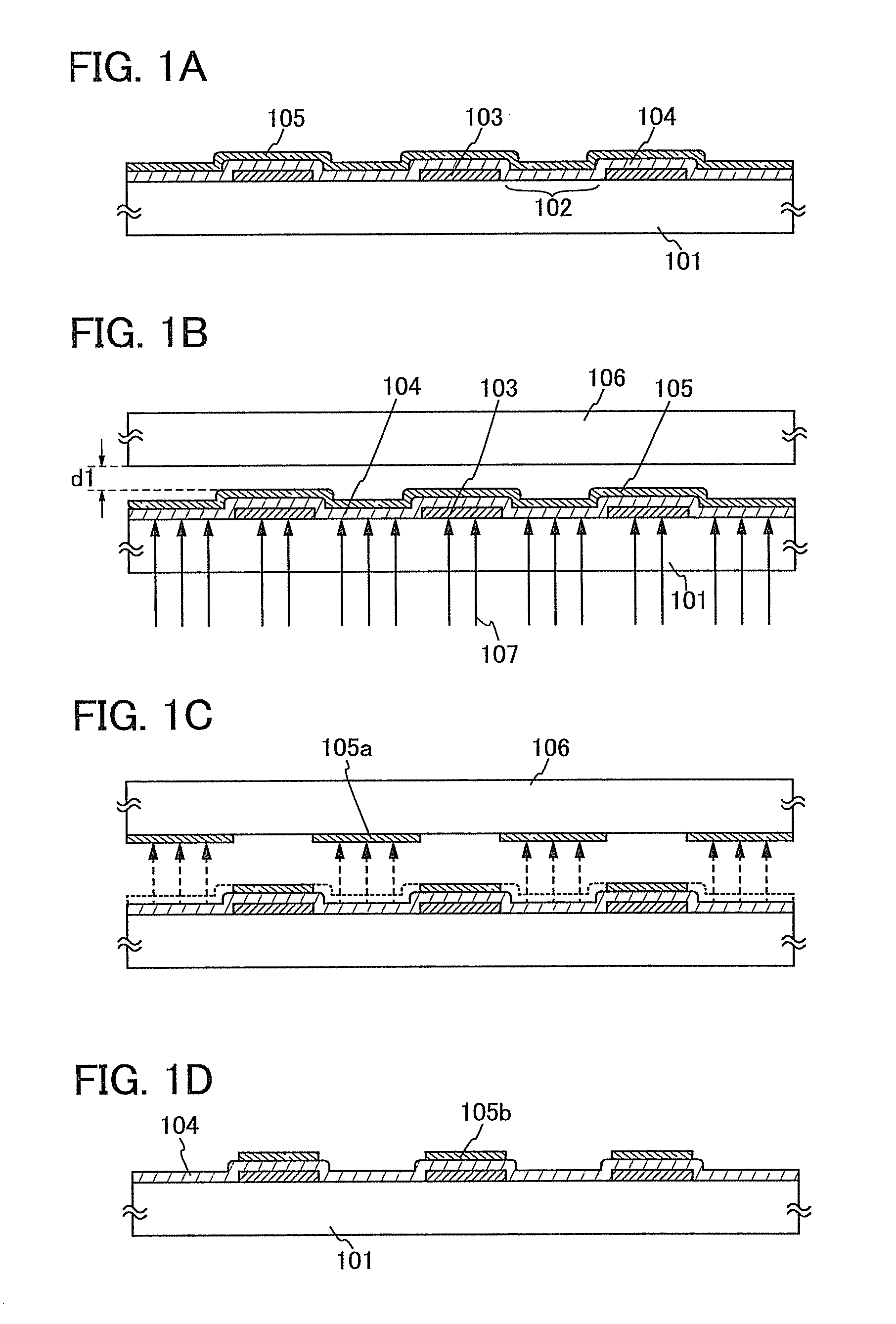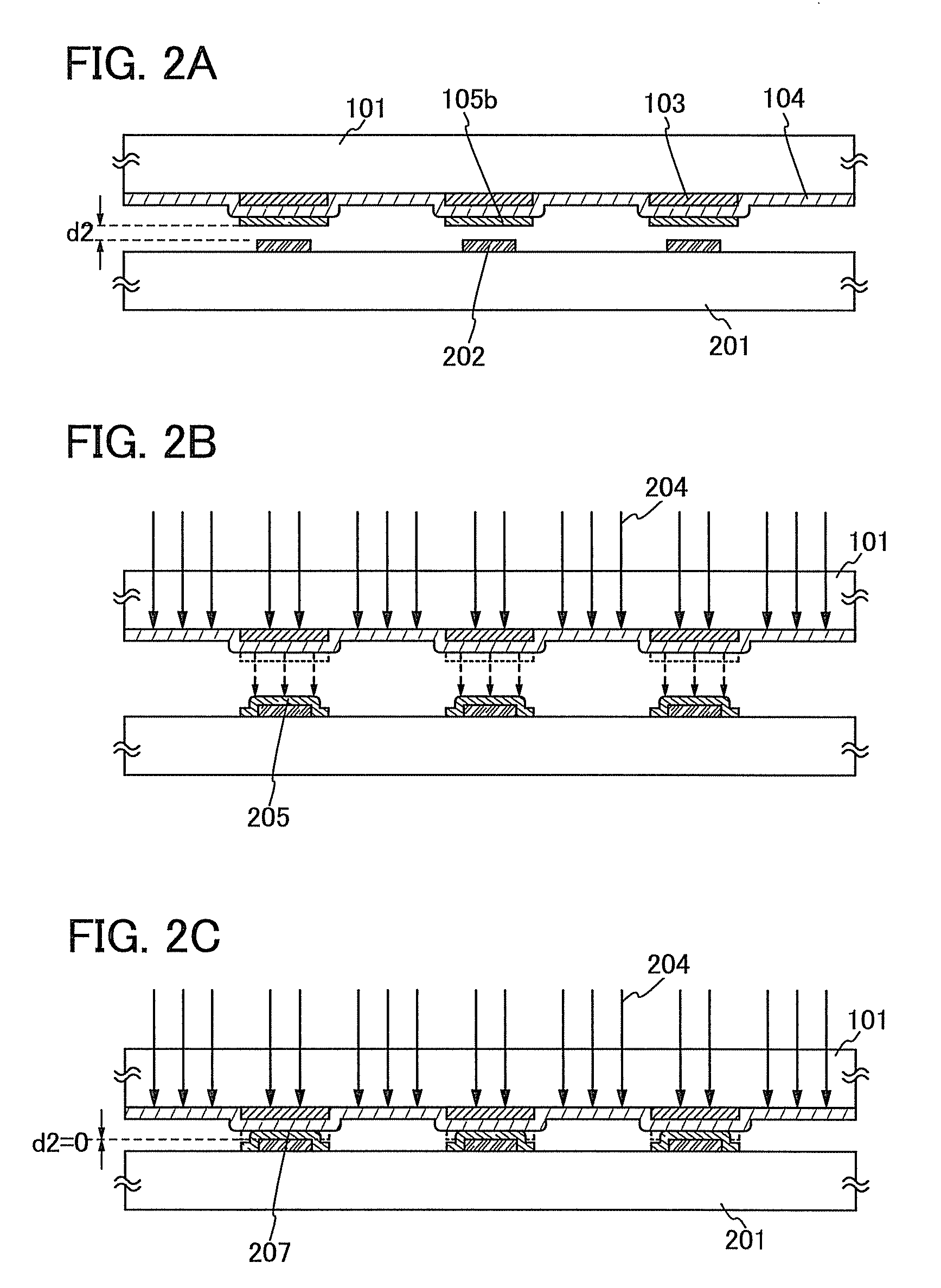Method for manufacturing light-emitting device
a technology of light-emitting devices and manufacturing methods, which is applied in the direction of identification means, instruments, vacuum evaporation coatings, etc., can solve the problems of poor film quality and high risk of uneven film formation in this manner, and achieve high light-emitting characteristics, high accuracy, and high definition
- Summary
- Abstract
- Description
- Claims
- Application Information
AI Technical Summary
Benefits of technology
Problems solved by technology
Method used
Image
Examples
embodiment 1
[0043]Embodiment 1 describes a deposition method in which an evaporation donor substrate is used. Note that Embodiment 1 describes the case where an evaporation material is patterned over the evaporation donor substrate and an EL layer of a light-emitting element is formed with use of the patterned evaporation material.
[0044]The evaporation donor substrate used in this embodiment is described with reference to FIGS. 1A to 1D. As illustrated in FIG. 1A, a reflective layer 103 including an opening portion 102 is formed over a first substrate 101 which is a supporting substrate and a light absorption layer 104 is formed over the first substrate 101 and the reflective layer 103. Note that part of the light absorption layer 104 is formed so as to fill the opening portion 102.
[0045]Further, a material layer 105 is formed over the light absorption layer 104. In FIG. 1A, each of the reflective layer 103 including the opening portion 102, the light absorption layer 104, and the material laye...
embodiment 2
[0090]Embodiment 2 describes an apparatus which is used when an evaporation donor substrate is irradiated with a laser light as a light source of first light, in a deposition method with use of the evaporation donor substrate described in Embodiment 1.
[0091]FIG. 4 is a perspective view illustrating an example of an apparatus using a laser light. The laser light is emitted from a laser oscillator 403 (a YAG laser apparatus, an excimer laser apparatus, or the like) and transmitted through a first optical system 404 for changing a laser light shape into a rectangular shape, a second optical system 405 for shaping the laser beam, and a third optical system 406 for collimating the laser beam. Then, an optical path is bent in a direction perpendicular to a first substrate 401, which is an evaporation donor substrate over a first substrate stage 409, by using a reflecting mirror 407. After that, the first substrate 401 is irradiated with the laser beam.
[0092]Note that a structure of the ev...
embodiment 3
[0101]Embodiment 3 describes an apparatus which is used when an evaporation donor substrate including a patterned material layer is irradiated with a lamp light used as a light source of second light in a deposition method employing the evaporation donor substrate described in Embodiment 1.
[0102]In FIG. 5A, a deposition chamber 501, which is a vacuum chamber, is interlocked with another processing chamber by a gate valve 502 and further provided with an exhaust mechanism 503. In addition, the deposition chamber 501 includes at least a substrate stage 504 for keeping a first substrate 511 (including a material layer 513) which is an evaporation donor substrate, a substrate supporting mechanism 505 for keeping a third substrate 512 which is a deposition target substrate, and a light source 510.
[0103]Note that a material layer of the first substrate 511 kept on the substrate stage 504 is patterned by performing the treatment described in Embodiment 1 or Embodiment 2 in another processi...
PUM
| Property | Measurement | Unit |
|---|---|---|
| reflectance | aaaaa | aaaaa |
| reflectance | aaaaa | aaaaa |
| reflectance | aaaaa | aaaaa |
Abstract
Description
Claims
Application Information
 Login to View More
Login to View More - R&D
- Intellectual Property
- Life Sciences
- Materials
- Tech Scout
- Unparalleled Data Quality
- Higher Quality Content
- 60% Fewer Hallucinations
Browse by: Latest US Patents, China's latest patents, Technical Efficacy Thesaurus, Application Domain, Technology Topic, Popular Technical Reports.
© 2025 PatSnap. All rights reserved.Legal|Privacy policy|Modern Slavery Act Transparency Statement|Sitemap|About US| Contact US: help@patsnap.com



